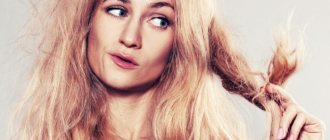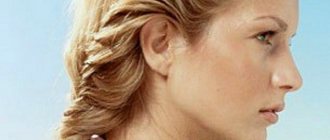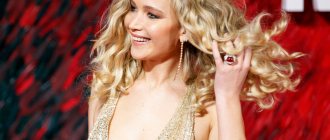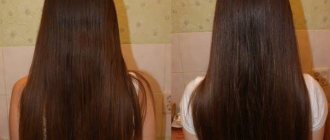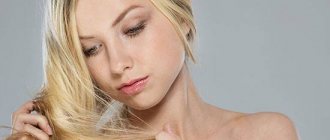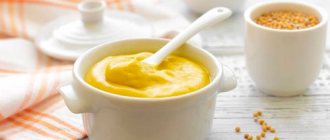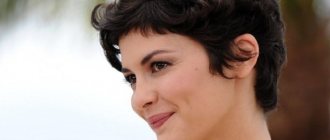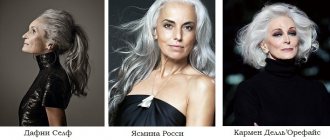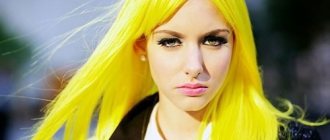Greetings, readers and guests of the blog! This time I want to talk to you about one topic that is very relevant in spring and at any other time of the year for many girls: restorative hair masks after coloring. After all, it is in spring that we want transformations, changes and something new.
A month ago I was in the mountains, snowboarding, and I must say, I was very lucky with the snow! But my joy from relaxing in the mountains gave way to slight disappointment due to the fact that I was riding around with my hair down and didn’t even bother to put it in a pigtail! And the results after skiing in the powder were absolutely disastrous: my curls got wet because of the snow, then froze and turned into icicles. And of course, this did not go unnoticed for my hair. The ice simply “torn” their structure from the inside, and they began to split, break and get tangled. The dyed strands turned yellow, became brittle and dry. In general, my once well-groomed curls looked very much like straw of an indistinct color...
And after I returned to Moscow, the first thing I did was run to my favorite hairdresser so that she could save me. But unfortunately, she completely refused to lighten my locks so as not to “kill” them, and she specially tinted them to remove the ugly yellowness.
Yes, after tinting the hair began to look more presentable, but the condition itself was simply deplorable... I had to restore my curls on my own. And, I managed to restore them in literally 20 days! Note that less than a month was enough to get them into a healthy state! So, are you wondering how I managed to do this? Then let's get started!
Mask for restoring hair structure
Daily use of a straightening iron or hair dryer without applying heat protectants spoils the hair and makes it lifeless. Damaged locks can be healed with familiar products. Garlic copes best with this task, as it restores the structure of the hair shaft.
Features of use
- Pass the garlic through a press.
- Add vegetable oil to the mixture if your hair is dry; Kefir is suitable for oily scalp.
- Rub the mixture in circular motions into the scalp.
- Wrap your hair in film.
- Insulate with a towel.
- Keep the mask for no more than 15 minutes, rinse with shampoo
- Rinse with cool water and lemon juice or apple cider vinegar. This will get rid of the obsessive odor and add shine to your hair.
- Do not use if scalp is damaged.
- Apply the mask 2 times a week for 3 months.
Hair restoration mask No. 4 – Kefir
Frequently coloring your hair at home deprives it of shine, strength and health. Lovers of bold experiments, often changing color, risk causing irreparable damage to their curls. A mask for colored hair made from kefir can revive dull, lifeless hair.
Ingredients
- fat kefir – 0.5 liters;
- egg yolk;
- olive oil – 5 tablespoons.
Recipe: combine kefir with olive oil, add beaten yolk and place in a blender. If you don't have one, you can use a whisk. Each portion of the mask should be taken with the palm of your hand and thoroughly rubbed into the scalp. The remaining mixture is distributed over the entire length of the hair. Cover the mask with cling film or a plastic bag and wrap it up. A towel, terry cloth or warm scarf is suitable for this purpose. Leave for half an hour and wash off. A kefir mask will give your hair softness and shine.
Oils are the leading ingredients in masks used to restore colored hair. They are helped by components that restore moisture and restore hair structure. When choosing the type of mask, you should consider your hair type: thin or hard and curly. Then the benefit of the procedure will be maximum.
Recipes for effective restorative masks
Recipe 1. Mask for bleached hair based on honey.
This recipe is intended to restore the structure of curls damaged by aggressive lightening. Natural honey has been used since ancient times to treat various hair problems. Using it as a basis, you can prepare an excellent mask that is suitable for any hair type.
So, to make the mixture, stock up on:
- liquid honey;
- fresh aloe juice;
- one yolk;
- olive or linseed oil (optional).
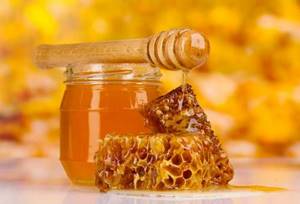
Combine honey with your chosen oil, place it in a water bath and warm to room temperature. Then add one or two yolks (you can use either chicken or quail eggs) and a small amount of fresh aloe juice. Thoroughly stir all the ingredients again until a homogeneous mass is formed. Apply the prepared mask to pre-washed hair and then wrap it with plastic wrap.
Recipe 2. Restoring mask for bleached curls.
Care for colored strands should be special; in this case, the emphasis is on hydration and nutrition. Weakened blonde hair will like a mask based on castor oil and quail eggs. It is recommended for use on normal and dry curls.
To prepare the product you need to prepare the following components:
- quail eggs;
- Castor oil;
- essential oils.
First, separate the whites from the yolks, beat the latter thoroughly until a thick foam forms. Whole eggs can also be used. After this, add castor oil. It can give the mass a not very pleasant smell, so it is recommended to add a few drops of your favorite essential oils. The mask is applied to dirty hair, left for 25-30 minutes, and then washed off with shampoo. If necessary, you can do this twice.
Recipe 3. Cinnamon-based mask at home.
Cinnamon is used not only for culinary purposes, but also for cosmetic purposes. So, it helps to lighten natural hair a couple of shades, and also helps restore it after using aggressive dyes. With its help, you can activate the process of the appearance of new hairs and give light curls a rich mirror shine.
The mask is made from the following components:
- cinnamon;
- cognac or vodka;
- honey;
- colorless henna.
First, combine all the ingredients, stir them thoroughly and heat slightly. This mask will bring even more benefits and will be most effective when used warm. Apply the resulting mixture to your curls and wrap them in a plastic bag or a special cap. After this, you can further heat your hair with a hairdryer. Leave the mask to act for 30-40 minutes, and then thoroughly rinse your curls to remove any residue.
Recipe 4. Oily mask for bleached strands.
Caring for curls after the lightening procedure involves the use of various nutritional mixtures. For this purpose, oily masks are most suitable, which are great for dry hair. We offer you a proven recipe that will help you get your hair in perfect order.
To make a mask, you need to prepare a number of components, namely:
- egg yolks;
- Castor oil;
- olive oil.
First you need to mix olive and castor oils. Then you need to distribute them evenly along the entire length of the hair, paying special attention to the ends. Leave the mask on your hair for about half an hour and then wash it off. This will be easier if you use egg yolks.
Recipe 5. Mask based on linseed oil at home.
This recipe will help maintain the desired color for a long time, and will also effectively restore damaged curls.
To make a mask you will need the following:
- honey;
- flax oil;
- grape.
First, crush the grapes, combine them with honey and flax oil melted in a water bath. After this, mix the resulting mixture thoroughly and use it several times a week. Leave it on your curls for 40 to 50 minutes and then rinse with water at room temperature.
We hope that the above recipes for restorative masks will be useful to you and will help you get your hair in order as soon as possible. The obvious advantage of masks is that they are easy to make at home, and you don’t need to spend a lot of money, because all the ingredients can be found in your kitchen. Use the power of nature and always be beautiful!
Do I need to shave vellus hair?
Vellus hair, coming out in large quantities, gives a certain volume, but does not look at all like stubble. This fact is alarming, even raising two questions:
- Will thin fluff ever become thick?
- Shave it or not?
Answering the first question, we note right away: gradually such hairs thicken, but only at the base. The tip, as expected, grows back, remaining the same light and thin. That is why the main advice: vellus hairs must be shaved off. But! It is important to understand the following: by cutting off the tip, we get an increasingly thick base. That is, shaving itself does not affect the appearance of stubble - this is the first important point. Second: the blade removes thin parts of the hair, thereby bringing you closer to the treasured stubble. This is precisely where its main positive effect lies.
Important note! After using minoxidil for your beard for a long time and regularly shaving off the fuzz that appears, you will get thicker, coarser beard hairs - and there will be a lot of them. Consequently, the stubble will become thicker, smoother, and more noticeable. However, in some men, the new hairs awakened by using the drug may still not reach the same degree of stiffness and thickness as the original ones. What to do? Nothing. This is a feature of your body that you just have to come to terms with.
Conclusion: shaving while using minoxidil is advisable. This way you will quickly achieve smooth, beautiful and thick stubble. Still, thin vellus hair of great length is not aesthetically pleasing and untidy. However, using a razor is not a prerequisite for success. The hair will grow back anyway, but how it will look depends only on you.
Is it possible to shave off stubble while using minoxidil?
Here the answer is simple: yes. The use of the blade does not affect the effectiveness of the drug in any way. Only here it is important to take into account some points.
First, be sure to trim the machine correctly: it should be sharp, comfortable, and effective. It is these devices that carefully cut hairs and do not pull them out. There is an opinion among men that using a razor ruins the beard. It is believed that the bristles are still very weak, the hairs on them are easy to injure or even pull out, thereby spoiling the effect of using the drug. This is wrong. Get the right machine and everything will be fine.
The second argument in favor of shaving. When you cut the hairs, the upper layer of the dermis is also cleansed, dead cells are removed, which allows minoxidil to be absorbed and absorbed much better. It is clear that the effect of using the drug increases.
Finally, let’s answer one more question: how often can you shave? In principle, as needed, for many this is once every two or three days. There can be no definite answer here: see what suits you.
Caring for colored hair
Taking care of your hair at home is not so difficult if you adhere to the basic principles:
- consistency - care activities should be carried out regularly, regardless of the time of year and daily busyness;
- complexity - in order for the curls to receive the necessary nutrition, saturation and restoration, washing your hair alone will not be enough, you need to use special products, homemade masks and monitor your diet;
- systematicity - strict adherence to the established course of hair care, with a certain alternation of procedures.
How to wash your hair correctly?
To ensure that the color of your dyed strands lasts as long as possible and the shade is rich, you need to wash your hair properly. After the dyeing procedure, you should not wash your hair for 2-3 days - this will allow the pigment to set.
You also need to be careful when choosing a shampoo: it is better to use a product for colored hair. You can even choose a shampoo that matches your hair tone - there are now fixing shampoos on sale for blondes, brunettes and redheads.
If your hair requires frequent washing, it is better to use a mild, gentle shampoo with an acidic pH level. It neutralizes the alkali that paints leave behind and helps restore the hair structure.
Dyed hair is more prone to breakage than others, especially after washing. It is not recommended to comb wet strands, otherwise there is a risk of damaging them even more. It is better to comb slightly damp hair and use a wide-tooth comb for this purpose.
You should dry your hair naturally or with a hair dryer at low speeds, using a cool stream of air.
Once a week, you can use a chicken egg instead of shampoo. To prepare the detergent, you need to mix several chicken eggs and warm water. Apply the mixture to wet hair, rubbing gently. Then rinse your head with warm water and comb your hair. The egg mixture will help remove dirt from your hair and restore moisture balance.
Rinsing colored hair
The rinsing procedure will maintain the rich color and update the shade. Herbs will come to the rescue.
For blondes, a decoction of chamomile flowers is suitable. Pour boiling water over dried flowers in a ratio of 1 to 5, put on fire and boil for 5 minutes. Cool the broth to a pleasant temperature and rinse your hair immediately after washing.
For red-haired people use hibiscus. Pour boiling water over several hibiscus inflorescences in a glass container and cover with a lid. The infusion is kept for at least 30 minutes, but it is better to prepare the product several hours before rinsing. The tincture should be filtered and added 500 ml of cold water. Rinse hair washed with shampoo.
The colder the hibiscus infusion, the more intense the shade and shine.
Brunettes and brown-haired women can try regular black tea as a rinse. Pour 2 tablespoons of large-leaf black tea into two glasses of boiling water and brew over low heat for 30 minutes. Cool and strain the resulting broth, use it as a rinse after washing.
After using any of the natural rinses, wash your hair with plain clean water.
Nourish and moisturize colored hair
After coloring, the curls must be provided with nutrients - primarily from the outside.
For this purpose, nourishing and moisturizing mass-market, professional or home-made masks are suitable.
The simplest and most effective recipes:
- Add sunflower and castor oils in equal proportions to shampoo for colored hair. Apply the product to damp hair, wrap your head for a couple of hours, then rinse thoroughly with warm water.
- Mix the yolk of one egg with 1 tablespoon of honey, add a few drops of ylang-ylang oil and rosemary. Stir and apply the mixture to water-moistened hair for an hour and a half. Rinse with warm water, then wash hair with shampoo.
- Burdock oil for colored hair is used in its pure form. Before use, you need to warm it up, rub a few drops in your palms and treat wet strands along the entire length. To enhance the effect, you should warm your head and leave the product on for at least 1 hour. Wash off with shampoo until the greasiness disappears.
Nourishing masks should be used once a week. They have a beneficial effect on hair, restore the lack of nutrients and moisture and stimulate growth.
Mask for colored hair recipe
Homemade mask for strengthening hair
Ingredients of a homemade mask: - one teaspoon of castor oil, one teaspoon of burdock oil, a tablespoon of pepper tincture, mix all the ingredients well and apply to the hair as usual. Leave the strengthening mask on your hair for forty minutes.
Take one egg yolk and beat it with one spoon of vegetable oil. Apply the finished mixture to your hair for about twenty minutes.
Take two egg yolks, add to them one full tablespoon of natural honey, the same amount of burdock oil and mix all the ingredients. This homemade mask can improve the overall condition of colored hair.
Homemade masks for hair shine
The components of the shine mask are three egg yolks, 6 tablespoons of fresh lemon juice, 6 tablespoons of apple cider vinegar. It is advisable to keep the mask on your hair just a little, this will be enough to make your hair shine better.
The next homemade shine mask is for colored hair. Take one banana, one avocado, chop everything as finely as possible, then add beaten egg yolk and a small amount of natural honey, if desired, you can add one teaspoon of olive oil. The mask is applied to the hair for approximately thirty minutes and washed off only with warm water.
Homemade mask for colored hair. By constantly using a homemade hair mask, you can easily restore a beautiful and attractive shine to your hair, which will improve the overall appearance of your hair. To prepare the mask you will need the following ingredients and components: - one small bunch of grapes, a tablespoon of natural pure honey, the same amount of linseed oil. Mix all the components of the mask for colored hair to obtain a homogeneous mixture and apply to the hair. A homemade mask for colored hair must be left on the hair for twenty to thirty minutes. The mask should be washed off with plenty of acidified water.
It is believed that modern hair dye does not cause harm to the hair, but only provides vitamins, benefits and a healthy appearance. In fact, there is some truth in this statement, but, in addition, the condition of the hair is also affected by the fact of frequent dyeing and other traumatic actions, which means that there is a need for masks for colored hair, as well as those that have not been dyed.
In addition to damaging the hair structure, coloring leads to loss of shine. The dye itself gives shine, but over time it fades and the hair loses its attractiveness. Homemade hair masks will help overcome dryness and brittleness.
Experts have differing opinions regarding the use of oils (burdock, castor or olive) as a mask for colored hair. On the one hand, oil is an excellent way to improve hair health. On the other hand, oil promotes rapid loss of color, so it is rarely used for colored hair.
Grape mask for colored hair
Hair coloring will not be so traumatic if you pamper your hair with a grape delicacy from time to time. To prepare it, mix 50 g of mashed grapes and a tablespoon of honey and flaxseed oil. Apply the resulting mixture to your hair, and after 20-30 minutes, rinse with warm water and shampoo and rinse your hair several times, as The oil base does not wash off very quickly.
Egg masks for colored hair
Any women's magazine will advise you to alternate oil-containing masks with masks that do not contain a fatty substance. This is due to the property of oil to wash out the color from the hair, so we recommend regularly making yolk treats for your hairstyle.
This homemade mask for colored hair will help give shine to colored hair: 3 egg yolks are mixed with lemon juice and apple cider vinegar, taken in equal parts (60 ml each). The mask should be left on for no more than 5 minutes and then washed off with warm water.
If the hair is severely damaged by dyeing or bleaching, add a tablespoon of cognac and the same amount of fresh lemon juice to the yolks, as well as the contents of two gelatin capsules with vitamin E. The mask for colored hair should be kept for 20-30 minutes, after wrapping your head in a warm towel. This cocktail is washed off with warm water and shampoo.
Homemade mask for colored hair made from rye bread
Rye bread is poured with boiling water and left for 2-3 hours. Then the excess moisture is squeezed out, and the soaked bread is applied to the scalp and distributed through the hair. After half an hour, wash the hair with clean water.
Electrolysis of vellus hair on the face
Sometimes, for various reasons, vellus hair on the face lengthens and becomes too noticeable in the sun. Most often this happens after pregnancy. Most of these hairs, which grow back due to an increase in the level of progesterone in the blood, fall out over time, and the hair that grows to replace them has its original growth program. This process can last 1-2 years, but not everyone experiences it this way. Of the hardware hair removal methods, vellus hair can only be removed by electrolysis, since there is simply nothing to absorb laser radiation in such hairs.
Watch the video below from electrolysis specialist Josepha Reyna to see how the procedure takes place. The master uses insulated needles, the flash method (advanced thermolysis). Here the hair is barely noticeable - this is one of the reasons why not all masters undertake to remove it: only the hair shaft is clearly visible in the light, and you have to look for the hair pore with a magnifying glass on your nose, turning your head to “catch” the reflection from the hair. This significantly reduces the speed of work and greatly tires the eyes. Pay attention to the needle. The fact is that the hair follicle of vellus hair is located very close to the surface of the skin, which increases the heat load on the skin, leading to redness and the formation of crusts. To protect the skin, Reina uses insulated needles.
The next video was also shot by Josepha Reyna, but this time the hair is slightly pigmented. Such hair can already be removed with a laser, if you are not afraid to be among those whose hair has degenerated into a beard after this procedure.
Not all electrolysis specialists undertake to remove fluff, even if it is colored and clearly visible. The reason is the following points to keep in mind.
Firstly, in the presence of hormonal diseases, it is possible that some of the vellus hair will be stimulated by androgens and turn into terminal hair. From the outside it will seem that this process is stimulated by electrolysis, and this is partly true, if the hair is removed selectively and not all in a row - after all, there is both skin irritation and heating, which act as stimulating factors even in the most favorable conditions.
Secondly, there is no “long” and “normal” fluff on the face. The hair grows gradually until it falls out. Old hair is the longest, and hair removal works best on young anagen hair, which looks like short and normally colored fluff. Therefore, the desire to remove only long hairs does not make any sense.
The third circumstance is that vellus hair grows for a relatively long time. As a rule, you need to clean the entire area, wait until the hair grows by 2-3 mm and do a new cleansing in its entirety. If you strip your hair selectively, you won’t be able to track the moment of hair regrowth.
Other on the topic:
- Electrolysis of hair on the auricle (hair removal on the ear lobe and tragus)
- Electrolysis of hair on hands and forearms
- Electrolysis of hair in the bikini area?
The best mask recipes for highlighted hair
The components included in the recipes below are available and cheap, and in terms of effectiveness they are in no way inferior to expensive industrial cosmetics. The only condition: all products used to prepare homemade mixtures must be fresh. In addition, you need to take into account that masks cannot be made for future use, since they cannot be stored, so the ingredients must be taken in quantities designed for one use, making allowances for the length and thickness of the hair.
Nourishing mask with grapefruit and linden honey for all hair types
A mask prepared according to this recipe saturates the curls with moisture and vitamins, returning strength, energy and vitality to them.
Compound:
- half a grapefruit;
- 1 ripe kiwi fruit;
- 50 g linden honey;
- 30 ml olive oil.
Preparation and use:
- Peel the grapefruit and kiwi and grind in a blender.
- Add honey and warm oil to the fruit pulp, mix and distribute the finished mixture onto dry strands.
- Warm your head and leave for about an hour.
- Rinse off the nutrient mixture with warm water and shampoo.
Vitamin mask with herbs for dry hair
This recipe is used to normalize the level of moisture and nutrients in hair follicles, prevent hair loss and enhance hair growth.
Compound:
- 20 g each of dried leaves of nettle, celandine and sage;
- 100 ml boiling water;
- 50 g honey;
- 1 ampoule of vitamins A and E.
Preparation and use:
- Pour boiling water over the plant material and let it brew for at least half an hour.
- Strain the resulting broth through cheesecloth, add honey and vitamins.
- Stir and distribute the vitamin mixture over the entire length of the strands.
- Warm your hair and leave for 40–50 minutes.
- Rinse your hair thoroughly with warm water and shampoo.
Curd mask with jojoba oil and mayonnaise for damaged hair
This composition is excellent for emergency restoration of overdried, severely damaged curls.
Compound:
- 70 g cottage cheese;
- 30 ml jojoba oil;
- 30 g mayonnaise.
Preparation and use:
- Mix cottage cheese with butter and mayonnaise and grind until smooth.
- Apply the resulting mixture to dry hair and warm your hair.
- After 40 minutes, rinse off the curd mask and rinse your hair several times with water and shampoo.
Kefir mask with sour cream and castor oil for unruly hair
This product perfectly moisturizes and strengthens curls, preventing their fragility and tangling.
Compound:
- 200 ml kefir;
- 50 g sour cream;
- 50 ml castor oil;
- 1 egg yolk.
Preparation and use:
- Pour the kefir into an enamel container and place it in a water bath.
- In another bowl, beat sour cream, yolk and butter.
- Combine the resulting mass with warm kefir, mix and lubricate the strands along the entire length with the prepared mixture.
- Wrap your hair in plastic and wait at least an hour.
- Wash off the kefir mask with plenty of water and shampoo.
Lemon mask with celandine for oily hair
This mask helps eliminate greasy shine, prevent hair breakage and split ends. In addition, this product has a slight lightening effect and gives the curls a beautiful golden hue.
Compound:
- 1 lemon;
- 20 g dried celandine;
- 100 ml boiling water;
- 150 ml kefir;
- 30 g flower honey.
Preparation and use:
- Pour boiling water over the celandine leaves and let them brew for a while.
- Squeeze the juice from the lemon and mix it with kefir and honey.
- Strain the celandine infusion through cheesecloth and combine it with the kefir mixture.
- Mix everything and distribute the liquid mass on dry strands.
- Warm your head and wait about 40 minutes.
- Rinse your hair well with warm water (without shampoo).
Homemade masks for highlighted hair can restore health, silkiness and dazzling shine to your curls, as well as enhance the effect of coloring. Such “therapy” can be carried out not only if there are obvious problems with the hair, when it looks dehydrated and lifeless, but also to prevent dryness and brittleness of strands that are subject to frequent dyeing. Remember that the key to healthy and beautiful curls is regular care and careful treatment.
Proper hair care at home
If you like to use chemical pigments to change the color of your hair, then you need to know how to properly care for it. They will help achieve hair restoration after contact with artificial pigment, maintain the health and strength of curls, and also preserve the new shade of the hair mask after dyeing.
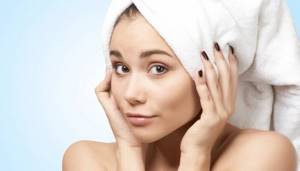
You can spend a lot of money and buy them in specialty stores. Only expensive drugs contain natural ingredients. But if you wish, you can make a mask yourself by purchasing the ingredients in a store or a nearby pharmacy.
Masks for hair restoration after coloring are often made using natural oils. The most effective are considered:
- burdock;
- castor;
- olive;
- almond;
- from tea tree extract.
The composition of restorative hair masks after coloring includes herbal tinctures of nettle or oregano; plantain and sage are also suitable. Sour cream and honey, chicken protein or yolk and bread (rye or black), fruits - bananas and avocados, lemon and kiwi also have a good effect on the condition of hair.
Let's look at several recipes for preparing masks after hair coloring at home, but remember that they should not be done once, immediately after the process, but regularly, alternating them according to the type of effect. For example, replace restorative ones with nourishing ones, and those that fight hair loss with vitamins or dandruff ones.
